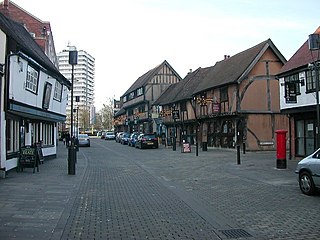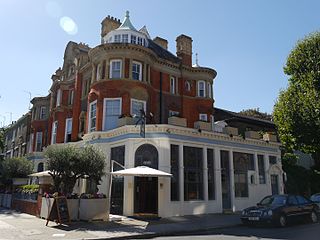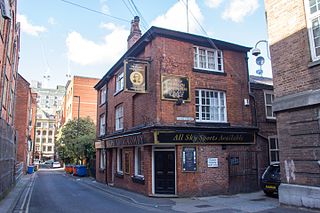
A pub is a drinking establishment licensed to serve alcoholic drinks for consumption on the premises. The term first appeared in the late 17th century, to differentiate private houses from those open to the public as alehouses, taverns and inns. Today, there is no strict definition, but CAMRA states a pub has four characteristics:
- is open to the public without membership or residency
- serves draught beer or cider without requiring food be consumed
- has at least one indoor area not laid out for meals
- allows drinks to be bought at a bar

The Bartons Arms is a public house in the High Street in the Newtown area of Aston, Birmingham, England.

Ancoats is an area of Manchester, England, next to the Northern Quarter, the northern part of Manchester city centre.

The Marble Brewery is a microbrewery in Manchester, England which makes cask ale from organic and vegetarian ingredients.

The Salisbury is a Grade II* listed pub on Grand Parade in Harringay, North London.

The Princess Louise is a public house situated on High Holborn, a street in central London. Built in 1872, it is best known for its well-preserved 1891 Victorian interior, with wood panelling and a series of booths around an island bar. It is a tied house owned by the Samuel Smith Brewery of Tadcaster, Yorkshire.

There are 236 Grade II* listed buildings in Greater Manchester, England. In the United Kingdom, the term listed building refers to a building or other structure officially designated as being of special architectural, historical or cultural significance; Grade II* structures are those considered to be "particularly significant buildings of more than local interest". In England, the authority for listing under the Planning Act 1990 rests with English Heritage, a non-departmental public body sponsored by the Department for Culture, Media and Sport.

New Islington is an inner city area of Manchester, in North West England. Historically in Lancashire and part of Ancoats, it has taken a separate identity to reflect its changed status as a regeneration area.

Spon Street is an historic street in central Coventry, in the West Midlands of England. The street was once part of a route that ran from Gosford to Birmingham – a route which remained intact until the 1960s. During the construction of Coventry's Inner Ring Road, built to relieve traffic on the narrow city centre streets, Spon Street was cut in half and the route severed.

Crocker's Folly is a Grade II* listed public house at 24 Aberdeen Place, St John's Wood, London. It was built in 1898, in a Northern Renaissance style, and was previously called The Crown. Geoff Brandwood and Jane Jephcote's guide to heritage pubs in London describes it as "a truly magnificent pub-cum-hotel" with "superb fittings", including extensive use of marble. The architect was Charles Worley.

The Seven Stars is a Grade II listed public house in Falmouth, Cornwall. It was built in about 1800 and subsequently extended in 1912 to include an off-licence, which later became a shop. The building was made of rendered stone, though the modern building is made of brick, both parts having a slate roof.

The Briton's Protection is a historic, Grade II listed public house in Manchester, England. Various dates are given for its establishment; the pub's own website says 1806, although its bicentenary was not celebrated until 2011. It was listed in Pigot and Dean's New Directory of Manchester & Salford for 1821 and 1822.

The Red Lion is a disused public house on Soho Road, in the Handsworth district of Birmingham, England.

The Nursery Inn is a suburban pub at 258 Green Lane in Heaton Norris, Stockport, Greater Manchester, England. It was built in 1939 in a sub-Georgian design with a multi-room layout, as a replacement of a 19th-century pub that was on the site.

The Sir Ralph Abercromby, also known as the Abercrombie, is a pub between Jackson's Row and Bootle Street, in Manchester, England, named after Lieutenant-General Sir Ralph Abercromby. Built in the 19th century, it is one of the few structures remaining in the area from the time of the Peterloo Massacre. Wounded people from the massacre were brought to the pub for medical treatment. Many later changes were made to the building, both inside and outside, with no substantial 19th century features remaining. It is thought to be the inspiration for the pub in Life on Mars.

The Chequers was a public house which occupied a Grade II listed building in Potters Bar, England. Originally opening in the 1700s, the pub moved site across the road and opened in its current location in the 1840s. Although there is no consensus as to when the current building was originally constructed, it started as two separate houses which were joined together before the pub moved onto the site.

The Commercial is a public house at 210-212 Railton Road, Herne Hill, London. It is cited in 'The CAMRA Regional Inventory for London' as being one of only 133 pubs in Greater London with a pub interior of special historic interest, most notably for its, "Original counters, bar-back, fireplaces and much fielded wall panelling" dating from the 1930s. In July 2016, Lambeth Council designated The Commercial as a locally-listed heritage asset of architectural or historic interest, being described as a, "Two-storey Neo Georgian style inter-war pub with a three-part convex façade which follows the curve of the building line".

The Peveril of the Peak is a historic public house in Manchester, England. The Campaign for Real Ale considers it to have an "interior of exceptional national historic importance."
The Castle Hotel is a historic public house in Manchester, England. The Campaign for Real Ale considers it to have an "interior of exceptional national historic importance."


















